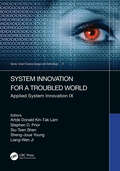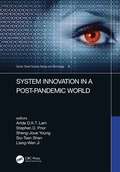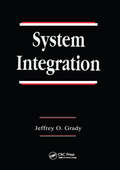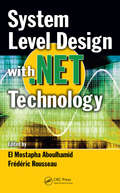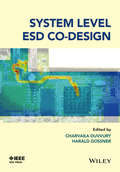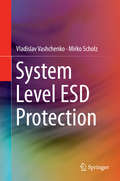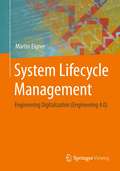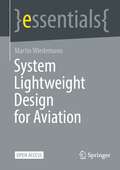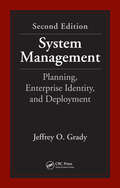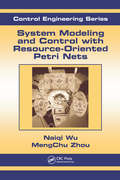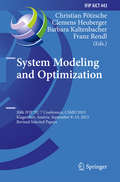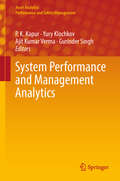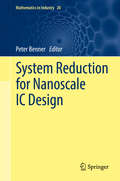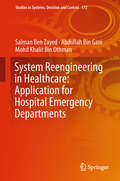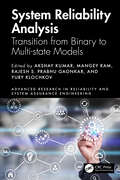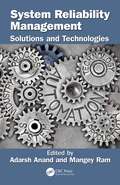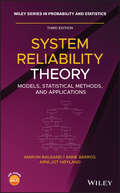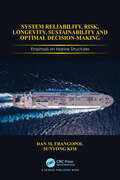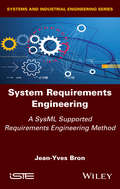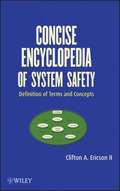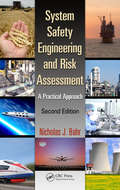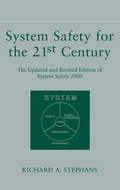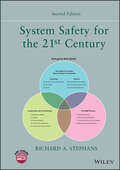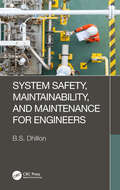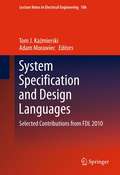- Table View
- List View
System Innovation for a World in Transition: Applied System Innovation IX. Proceedings of the 9th International Conference on Applied System Innovation 2023 (ICASI 2023), Chiba, Japan, 21-25 April 2023 (Smart Science, Design & Technology)
by Stephen D. Prior Siu-Tsen Shen Sheng-Joue Young Liang-Wen Ji Kin-Tak Lam, Artde DonaldSystem Innovation for a World in Transition: Applied System Innovation IX, includes the contributions presented at the IEEE 9th International Conference on Applied System Innovation (ICASI 2023, Chiba, Japan, 21-25 April 2023). The conference received more than 600 submitted papers from 12 different countries, whereby roughly one quarter of these papers was selected to present at ICASI 2023. The book aims to provide an integrated communication platform for researchers from a wide range of topics including information technology, communication science, applied mathematics, computer science, advanced material science, and engineering. Hopefully, it will enhance interdisciplinary collaborations between science and engineering technologists in the fields of academics and related industries.
System Innovation in a Post-Pandemic World: Proceedings of the IEEE 7th International Conference on Applied System Innovation (ICASI 2021), September 24-25, 2021, Alishan, Taiwan (Smart Science, Design & Technology)
by Artde Donald Kin-Tak LamSystem Innovation in a Post-Pandemic World contains the papers presented at the IEEE 7th International Conference on Applied System Innovation (ICASI 2021, Alishan, Taiwan, September 24-25, 2021). The conference received more than 200 submitted papers from 11 different countries, whereby roughly one third of these papers was selected by the committees and invited to present at ICASI 2021. The book provides an integrated communication platform for researchers from a wide range of disciplines including information technology, communication science, applied mathematics, computer science, advanced material science, and engineering. Hopefully, interdisciplinary collaborations between science and engineering technologists in the domains of academia and industry will be enhanced via this unique international network.
System Integration (Systems Engineering Ser. #5)
by Jeffrey O. GradySystem Integration presents the systems approach to complex problem solving and provides a powerful base for both product and process integration. This unique reference describes 27 kinds of integration work, primarily obtained through human communications. Simple computer applications-already in place in most companies-have the resources to encourage the availability and sharing of current team knowledge, which results in an intense, cooperative experience leading rapidly to sound design solutions.
System Level Design with .Net Technology
by Frédéric Rousseau El Mostapha AboulhamidThe first book to harness the power of .NET for system design, System Level Design with .NET Technology constitutes a software-based approach to design modeling verification and simulation. World class developers, who have been at the forefront of system design for decades, explain how to tap into the power of this dynamic programming environment for more effective and efficient management of metadata—and introspection and interoperability between tools. Using readily available technology, the text details how to capture constraints and requirements at high levels and describes how to percolate them during the refinement process. Departing from proprietary environments built around System Verilog and VHDL, this cutting-edge reference includes an open source environment (ESys.NET) that readers can use to experiment with new ideas, algorithms, and design methods; and to expand the capabilities of their current tools. It also covers: Modeling and simulation—including requirements specification, IP reuse, and applications of design patterns to hardware/software systems Simulation and validation—including transaction-based models, accurate simulation at cycle and transaction levels, cosimulation and acceleration technique, as well as timing specification and validation Practical use of the ESys.NET environment Worked examples, end of chapter references, and the ESys.NET implementation test bed make this the ideal resource for system engineers and students looking to maximize their embedded system designs.
System Level ESD Co-Design
by Harald Gossner Charvaka DuvvuryAn effective and cost efficient protection of electronic system against ESD stress pulses specified by IEC 61000-4-2 is paramount for any system design. This pioneering book presents the collective knowledge of system designers and system testing experts and state-of-the-art techniques for achieving efficient system-level ESD protection, with minimum impact on the system performance. All categories of system failures ranging from 'hard' to 'soft' types are considered to review simulation and tool applications that can be used. The principal focus of System Level ESD Co-Design is defining and establishing the importance of co-design efforts from both IC supplier and system builder perspectives. ESD designers often face challenges in meeting customers' system-level ESD requirements and, therefore, a clear understanding of the techniques presented here will facilitate effective simulation approaches leading to better solutions without compromising system performance. With contributions from Robert Ashton, Jeffrey Dunnihoo, Micheal Hopkins, Pratik Maheshwari, David Pomerenke, Wolfgang Reinprecht, and Matti Usumaki, readers benefit from hands-on experience and in-depth knowledge in topics ranging from ESD design and the physics of system ESD phenomena to tools and techniques to address soft failures and strategies to design ESD-robust systems that include mobile and automotive applications. The first dedicated resource to system-level ESD co-design, this is an essential reference for industry ESD designers, system builders, IC suppliers and customers and also Original Equipment Manufacturers (OEMs). Key features: * Clarifies the concept of system level ESD protection.* Introduces a co-design approach for ESD robust systems.* Details soft and hard ESD fail mechanisms.* Detailed protection strategies for both mobile and automotive applications.* Explains simulation tools and methodology for system level ESD co-design and overviews available test methods and standards.* Highlights economic benefits of system ESD co-design.
System Level ESD Protection
by Vladislav Vashchenko Mirko ScholzThis book addresses key aspects of analog integrated circuits and systems design related to system level electrostatic discharge (ESD) protection. It is an invaluable reference for anyone developing systems-on-chip (SoC) and systems-on-package (SoP), integrated with system-level ESD protection. The book focuses on both the design of semiconductor integrated circuit (IC) components with embedded, on-chip system level protection and IC-system co-design. The readers will be enabled to bring the system level ESD protection solutions to the level of integrated circuits, thereby reducing or completely eliminating the need for additional, discrete components on the printed circuit board (PCB) and meeting system-level ESD requirements. The authors take a systematic approach, based on IC-system ESD protection co-design. A detailed description of the available IC-level ESD testing methods is provided, together with a discussion of the correlation between IC-level and system-level ESD testing methods. The IC-level ESD protection design is demonstrated with representative case studies which are analyzed with various numerical simulations and ESD testing. The overall methodology for IC-system ESD co-design is presented as a step-by-step procedure that involves both ESD testing and numerical simulations.
System Lifecycle Management: Engineering Digitalization (Engineering 4.0)
by Martin EignerYears of experience in the area of Product Lifecycle Management (PLM) in industry, research and education form the basis for this overview. The author covers the development from PDM via PLM to SysLM (System Lifecycle Management) in the form commonly used today, which are necessary prerequisites for the sustainable development and implementation of IoT/IoS, Industry 4.0 and Engineering 4.0 concepts. The building blocks and properties of future-proof systems for the successful implementation of the concepts of Engineering 4.0 are thereby dedicated to holistic considerations, which also inform in detail. SysLM functions and processes in mechatronic development and design as well as across the entire product lifecycle - from requirements management to the Digital Twin - are covered as examples. SysLM trends such as low code development, cloud, disruptive business models, and bimodality provide an outlook on future developments. The author dedicates the treatment of the agile SysLM introduction to the implementation in the enterprise. The basics are deepened with examples of a concrete SysLM system.
System Lightweight Design for Aviation (essentials)
by Martin WiedemannThis open access book presents technologies and methods of lightweight system design to support future low-emission aviation in achieving climate targets. It will be shown how reduction of weight and aerodynamic drag affects the energy consumption of commercial aircraft and what characterizes lightweight system design. Methods, design principles, production technologies and options for functional integration are available for more energy-efficient aircraft. Research results from the last decade are presented, which are intended to encourage the reader to further research and, above all, to implement them in future aircraft.
System Management: Planning, Enterprise Identity, and Deployment, Second Edition (Systems Engineering)
by Jeffrey O. GradyThe second edition of a bestseller, System Management: Planning, Enterprise Identity, and Deployment demonstrates how to make systems development work for any organization. Updated with new chapters, examples, and figures, it discusses the optimum marriage between specific program planning and a company's generic identity. The author focuses on the
System Modeling and Control with Resource-Oriented Petri Nets (Automation and Control Engineering)
by MengChu Zhou Naiqi WuPetri nets are widely used in modeling, analysis, and control of discrete event systems arising from manufacturing, transportation, computer and communication networks, and web service systems. However, Petri net models for practical systems can be very large, making it difficult to apply such models to real-life problems.System Modeling and Control with Resource-Oriented Petri Nets introduces a new resource-oriented Petri net (ROPN) model that was developed by the authors. Not only does it successfully reduce model size, but it also offers improvements that facilitate effective modeling, analysis, and control of automated and reconfigurable manufacturing systems. Presenting the latest research in this novel approach, this cutting-edge volume provides proven theories and methodologies for implementing cost and time-saving improvements to contemporary manufacturing systems. It provides effective tools for deadlock avoidance—deadlock-free routing and deadlock-free scheduling. The authors supply simple and complex industrial manufacturing system examples to illustrate time-tested concepts, theories, and approaches for solving real-life application problems. Written in a clear and concise manner, the text covers applications to automated and reconfigurable manufacturing systems, automated guided vehicle (AGV) systems, semiconductor manufacturing systems, and flexible assembly systems. Explaining complex concepts in a manner that is easy to understand, the authors provide the understanding and tools needed for more effective modeling, analysis, performance evaluation, control, and scheduling of engineering processes that will lead to more flexible and efficient manufacturing systems.
System Modeling and Optimization
by Christian Pötzsche Clemens Heuberger Barbara Kaltenbacher Franz RendlThis book is a collection of thoroughly refereed papers presented at the 26th IFIP TC 7 Conference on System Modeling and Optimization, held in Klagenfurt, Austria, in September 2013. The 34 revised papers were carefully selected from numerous submissions. They cover the latest progress in a wide range of topics such as optimal control of ordinary and partial differential equations, modeling and simulation, inverse problems, nonlinear, discrete, and stochastic optimization as well as industrial applications.
System Performance and Management Analytics (Asset Analytics)
by Ajit Kumar Verma P. K. Kapur Yury Klochkov Gurinder SinghThis book shares key insights into system performance and management analytics, demonstrating how the field of analytics is currently changing and how it is used to monitor companies’ efforts to drive performance.Managing business performance facilitates the effective accomplishment of strategic and operational goals, and there is a clear and direct correlation between using performance management applications and improved business and organizational results. As such, performance and management analytics can yield a range of direct and indirect benefits, boost operational efficiency and unlock employees’ latent potential, while at the same time aligning services with overarching goals.The book addresses a range of topics, including software reliability assessment, testing, quality management, system-performance management, analysis using soft-computing techniques, and management analytics. It presents a balanced, holistic approach to viewing the world from both a technical and managerial perspective by considering performance and management analytics. Accordingly, it offers a comprehensive guide to one of the most pressing issues in today’s technology-dominated world, namely, that most companies and organizations find themselves awash in a sea of data, but lack the human capital, appropriate tools and knowledge to use it to help them create a competitive edge.
System Reduction for Nanoscale IC Design
by Peter BennerThis book describes the computational challenges posed by the progression toward nanoscale electronic devices and increasingly short design cycles in the microelectronics industry, and proposes methods of model reduction which facilitate circuit and device simulation for specific tasks in the design cycle. The goal is to develop and compare methods for system reduction in the design of high dimensional nanoelectronic ICs, and to test these methods in the practice of semiconductor development. Six chapters describe the challenges for numerical simulation of nanoelectronic circuits and suggest model reduction methods for constituting equations. These include linear and nonlinear differential equations tailored to circuit equations and drift diffusion equations for semiconductor devices. The performance of these methods is illustrated with numerical experiments using real-world data. Readers will benefit from an up-to-date overview of the latest model reduction methods in computational nanoelectronics.
System Reengineering in Healthcare: Application for Hospital Emergency Departments (Studies in Systems, Decision and Control #172)
by Salman Ben Zayed Abdullah Bin Gani Mohd Khalit Bin OthmanThis book presents an advanced systematic mapping review (SMR) and state-of-the-art taxonomy of emergency departments (EDs). Focusing on the patients’ level of fulfilment and how it can be enhanced, it examines existing problems like waiting periods and overcrowding and how these can be alleviated to provide a better service. The author examined research papers from 1964 to 2018, and developed six research questions, organising them using mapping studies, the primary objectives of which were firstly, to obtain a common understanding of the problems that need to be highlighted in EDs, and secondly, to re-analyse the methods used. Focusing on quality, the book encourages citations of experimental methods from important studies concerning EDs that can improve services. Through different research papers, various thematic areas in the healthcare sector were examined, like the determination of the relative efficiency of pre-discharge interventions; the analysis of care and managing common indications during the last stages of life; using e-Health to enhance effectiveness and proficiency; the seriousness of patient differences among EDs; the identification of quality problems in healthcare contexts; existing opportunities and the suggested plans. The book concludes that an analytical decision-making process should be used to assess a health technology on the basis of its performance. It stresses the importance of updating this analytical system frequently.
System Reliability Analysis: Transition from Binary to Multi-state Models (Advanced Research in Reliability and System Assurance Engineering)
by Mangey Ram Akshay Kumar Yury Klochkov Prabhu Gaonkar, Rajesh S.The text covers both basic and advanced techniques based on state performance systems and binary systems. The chapters will highlight reliability prediction, series-parallel, and complex modeling. It presents a dynamic reliability analysis of safety-critical systems using Petri nets, and dynamic resource allocation modeling of software with patching. The text illustrates a semi-Markov analysis of systems with a Weibull interface.This book: discusses in a comprehensive manner the reliability-centered maintenance modeling of electric vehicle systems; covers the reliability modeling of multi-state systems under the product development stage, and the reliability assessment of a multi-state degraded system; examines the role of nature-inspired techniques in the reliability optimization of systems; explores the practical challenges and solutions for RAMS management of train control systems; and showcases the methodology for the assessment of multi-state system reliability of traction electric drives, including overload modes. It is primarily written for graduate students and academic researchers in the fields of industrial engineering, systems engineering, manufacturing engineering, production engineering, mechanical engineering, and mathematics.
System Reliability Management: Solutions and Technologies (Advanced Research in Reliability and System Assurance Engineering)
by Mangey Ram Adarsh AnandThis book provides the latest research advances in the field of system reliability assurance and engineering. It contains reference material for applications of reliability in system engineering, offering a theoretical sound background with adequate numerical illustrations. Included are concepts pertaining to reliability analysis, assurance techniques and methodologies, tools, and practical applications of system reliability modeling and allocation. The collection discusses various soft computing techniques like artificial intelligence and particle swarm optimization approach for reliability assessment. Importance of differentiating between the optimal release time and testing stop time of the software has been explicitly discussed and presented in the book. Features: Creates understanding of the costs associated with complex systems Covers reliability measurement of engineering systems Incorporates an efficient effort-based expenditure policy incorporating cost and reliability criteria Provides information for optimal testing stop and release time of software system Presents software performance and security layout Addresses reliability prediction and its maintenance through advanced analytics techniques Overall, System Reliability Management: Solutions and Techniques is a collaborative and interdisciplinary approach for better communication of problems and solutions to increase the performance of the system for better utilization and resource management.
System Reliability Theory: Models, Statistical Methods, and Applications (Wiley Series in Probability and Statistics #396)
by Marvin Rausand Anne Barros Arnljot HoylandHandbook and reference for industrial statisticians and system reliability engineers System Reliability Theory: Models, Statistical Methods, and Applications, Third Edition presents an updated and revised look at system reliability theory, modeling, and analytical methods. The new edition is based on feedback to the second edition from numerous students, professors, researchers, and industries around the world. New sections and chapters are added together with new real-world industry examples, and standards and problems are revised and updated. System Reliability Theory covers a broad and deep array of system reliability topics, including: · In depth discussion of failures and failure modes · The main system reliability assessment methods · Common-cause failure modeling · Deterioration modeling · Maintenance modeling and assessment using Python code · Bayesian probability and methods · Life data analysis using R Perfect for undergraduate and graduate students taking courses in reliability engineering, this book also serves as a reference and resource for practicing statisticians and engineers. Throughout, the book has a practical focus, incorporating industry feedback and real-world industry problems and examples.
System Reliability, Risk, Longevity, Sustainability and Optimal Decision Making: Emphasis on Marine Structures
by Dan M Frangopol Sunyong KimThis book provides the concepts and methodologies of probabilistic structural performance assessments and predictions for deteriorating structures, with emphasis on marine structures and special consideration of system reliability, risk, longevity, sustainability, and optimal decision making. It introduces a comprehensive framework for time-dependent structural performance analysis, incorporating maintenance strategies to estimate and/or extend service life of infrastructure systems. The integration of structural health monitoring highlights the pivotal role of data analytics in addressing uncertainties and optimizing service life management. Progressing from foundational theories to advanced optimization strategies for inspection, monitoring, and maintenance planning. This book, which is a valuable resource for students, engineers, researchers, decision-makers, and policymakers, critically addresses economic considerations through cost-benefit utility and information analysis. Additionally, the exploration of multi-objective optimization and optimal decision-making processes presents the intricate trade-offs involved in the stewardship of marine and civil infrastructure.
System Requirements Engineering: A SysML Supported Requirements Engineering Method
by Jean-Yves BronThe book deals with requirements engineering in the context of System Engineering. He proposes a method to guide this activity engineering. The method is supported by the SysML modeling language. A first chapter aims to present the context and the associated definitions, to position the requirements engineering in the processes system engineering, to define the modeling and its contributions, and to make the link with the management of IS projects. The second chapter is devoted to the proposed method for implementing the requirements engineering subprocesses. Each of the 8 activities the component is first described before specifying how the SysML language can be exploited to achieve it effectively. Proposal for a book Please fill out the questionnaire below and send it back to Chantal Menascé: c.menasce@iste.co.uk The 3rd chapter is an application of the method to define the needs of the stakeholders of a system. The example is built on the basis of the RobAFIS'2018 competition. The 4th chapter continues the application of the method in the continuity of the IS processes to define the requirements of the same system. The appendices present at the same time a toolbox to realize the engineering of the requirements but also the complete results of engineering in Chapters 3 and 4.
System Safety
by Clifton A. Ericson IiThe first comprehensive reference work covering safety professional terminology A convenient desk reference designed to fill a serious gap in the system safety body of knowledge, the Concise Encyclopedia of System Safety: Definition of Terms and Concepts is the first book explicitly devoted to defining system safety terms and concepts and designed to help safety professionals quickly and easily locate the definitions and information which they need to stay abreast of research new and old. Definitions for safety-related terminology currently differ between individual books, guidelines, standards, and even laws. Establishing a single common and complete set of definitions for the first time, with examples for each, the book revolutionizes the way in which safety professionals are able to understand their field. The definitive resource devoted to defining all of the major terms and concepts used in system safety and reliability in a single volume, Concise Encyclopedia of System Safety is the go-to book for systems safety engineers, analysts, and managers as they encounter new terms, or need an exact, technical definition of commonly used terms.
System Safety Engineering and Risk Assessment: A Practical Approach, Second Edition
by Nicholas J. BahrWe all know that safety should be an integral part of the systems that we build and operate. The public demands that they are protected from accidents, yet industry and government do not always know how to reach this common goal. This book gives engineers and managers working in companies and governments around the world a pragmatic and reasonable approach to system safety and risk assessment techniques. It explains in easy-to-understand language how to design workable safety management systems and implement tested solutions immediately.The book is intended for working engineers who know that they need to build safe systems, but aren’t sure where to start. To make it easy to get started quickly, it includes numerous real-life engineering examples. The book’s many practical tips and best practices explain not only how to prevent accidents, but also how to build safety into systems at a sensible price. The book also includes numerous case studies from real disasters that describe what went wrong and the lessons learned.See What’s New in the Second Edition: New chapter on developing government safety oversight programs and regulations, including designing and setting up a new safety regulatory body, developing safety regulatory oversight functions and governance, developing safety regulations, and how to avoid common mistakes in government oversight Significantly expanded chapter on safety management systems, with many practical applications from around the world and information about designing and building robust safety management systems, auditing them, gaining internal support, and creating a safety culture New and expanded case studies and "Notes from Nick’s Files" (examples of practical applications from the author’s extensive experience) Increased international focus on world-leading practices from multiple industries with practical examples, common mistakes to avoid, and new thinking about how to build sustainable safety management systems New material on safety culture, developing leading safety performance indicators, safety maturity model, auditing safety management systems, and setting up a safety knowledge management system
System Safety for the 21st Century
by Richard A. StephansSummarizes the current state of "front-end" risk-control techniquesMany approaches to risk control are possible. However, only through careful reading, evaluation, and study can one make the best choice of a practical philosophy for a system safety program. The goal is to apply the best scientific and engineering principles in the best way, resulting in the soundest and safest possible system.System Safety for the 21st Century provides in-depth coverage of this specialized discipline within the safety profession. Written for both technical and nontechnical reference, this clearly organized text serves as a resource for both students and practitioners. It gives basic and essential information about the identification, evaluation, analysis, and control of hazards in components, systems, subsystems, processes, and facilities.Integrating the changes to the field that have occurred since publication of the first edition, this revised and expanded resource offers:* Logical progression from basics to techniques to applications* New focus on process safety not found in other texts* A new and unique section on professionalism for system safety and other safety practitioners* Presentation of both system safety scope and essentials* Consistent chapter format for easy learning includes an introduction and summary for each chapter* Review questions reinforcing important points* A combination of basis requirements with practical experience* Information on selected techniques to assess hazards and provide management oversight* An updated section on protecting against external events in the light of the global terrorist threat* Critiques of existing systems, including those of the Department of Defense and the* Department of EnergyRelevant to industry, academia, and government, System Safety for the 21st Century is an essential resource for anyone studying or implementing proactive hazard identification and risk control techniques and procedures.
System Safety for the 21st Century
by Richard A. StephansSystem Safety for the 21st Century Explore an authoritative and complete exploration of basic and advanced concepts in system safety engineering The Second Edition of System Safety for the 21st Century delivers an authoritative primer on the identification, evaluation, analysis, and control of hazards to people, components, sub-systems, systems, processes, and facilities. The book offers readers a complete discussion on techniques within system safety, the discipline on process safety, as well as a comprehensive treatment on professionalism within the safety??industry. This new edition applies the concepts of system safety to medical disciplines and medical devices, offering readers the potential to have a significantly positive impact on the standing of American medical safety in the world. The latest edition also includes: A brand-new chapter on the risk management with current international and??U.S. government standards New material on process safety including EPA and OSHA implementation and??external reviews An Instructor Solutions Manual that includes course content and 30??chapters of review questions and answers Further clarifications on difficult concepts from the First Edition with updated??appendices and references Relevant to academia, industry, and government, System Safety for the 21st Century is an essential resource for anyone studying or implementing and managing proactive hazard identification and risk control techniques and procedures.
System Safety, Maintainability, and Maintenance for Engineers
by B.S. DhillonThe safety, maintainability, and maintenance of systems have become more important than ever before. Global competition and other factors are forcing manufacturers to produce highly safe and easily maintainable engineering systems. This means that there is a definite need for safety, maintainability, and maintenance professionals to work closely during the system design and other phases of a project, and this book will help with that. System Safety, Maintainability, and Maintenance for Engineers presents, in a single volume, what engineers will need when designing systems from the fields of safety, maintainability, and maintenance of systems when they have to all work together on one project and it provides information that the reader will require no previous knowledge to understand. Also offered are sources in the reference section at the end of each chapter so that the reader is able to find further information if needed. For reader comprehension, examples along with their solutions are included at the end of each chapter. This book will be useful to many people including design engineers; system engineers; safety specialists; maintainability engineers; maintenance engineers; engineering managers; graduate and senior undergraduate students of engineering; researchers and instructors of safety, maintainability, and maintenance; and engineers-at-large.
System Specification and Design Languages
by Tom J. Kaźmierski Adam MorawiecThis book brings together a selection of the best papers from the thirteenth edition of the Forum on specification and Design Languages Conference (FDL), which was held in Southampton, UK in September 2010. FDL is a well established international forum devoted to dissemination of research results, practical experiences and new ideas in the application of specification, design and verification languages to the design, modelling and verification of integrated circuits, complex hardware/software embedded systems, and mixed-technology systems.
